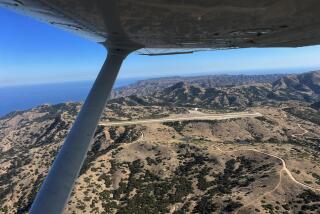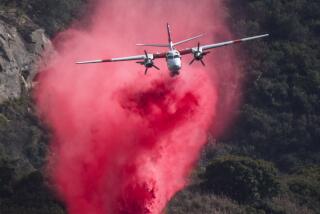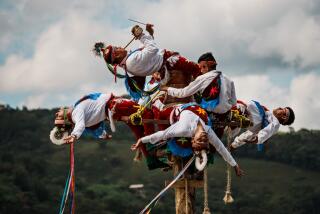TRIED & TRUE : Soaring on Wind and Wings
- Share via
All my life I’ve been fascinated by things that go up.
As a child, I used to fly kites off the precipice of a nearby hill.
Later, I graduated to miniature rockets propelled by fuels that shot them aloft, leaving white lines in the sky.
More recently, I started playing around with radio-controlled gliders, a skill at which I never attained much proficiency. After destroying several planes, in fact, I simply lost all confidence and gave it up.
Which makes it especially curious that now, in my middle and supposedly more mature years, I would suddenly develop a fascination for soaring. The sport is similar to flying a radio-controlled glider with one important difference: Instead of watching the plane from the ground, you ride in the plane. This leads to a big distinction in the similarities between the two: Your first crash is probably going to be your last.
“Don’t worry,” my pilot assured me just before takeoff. “The most dangerous part is getting here on the freeway.”
Indeed. To experience this death-defying act, my girlfriend, Joy, and I had spent more than 90 minutes driving out the 91 Freeway to Sailplane Enterprises at the Hemet-Ryan Airport in Riverside County.
The place is rather desolate looking, with portable outhouses and a dusty dirt road leading to a steaming hot parking place.
Once you get there, however, there’s a shaded patch of grass sporting comfortable benches from which you can watch the action, which generally consists of gliders being towed aloft by a single-engine tow plane and, much much later, returning alone with only the wind for fuel.
Constructed of sturdy aluminum, fiberglass and wood, sailplane gliders--with wingspans ranging from 40 to 72 feet--weigh 250 to 1,000 pounds. Yet carried by the wind, they can keep a pilot and up to two passengers aloft from 20 minutes to several hours.
“Our main objective is entertainment,” said Dottie Howell, who owns the company with her husband, Larry. “It’s for people who want to try something new and have a good experience.”
I was more nervous than entertained as I strapped myself tightly into the cockpit of the glider that, I’d been told, would shepherd me into the clouds. Seated directly behind me was my guardian and mentor, Mike Gunn, a 38-year-old trucker from Garden Grove who has been flying gliders for 15 years.
At a signal, the tow craft to which we were linked by a 200-foot line began slowly rolling down the runway. Piloting expertly from a duplicate set of controls in the rear seat, Gunn guided us gently aloft.
The experience began inauspiciously enough; as the ground sank below us, I barely noticed the height to which we were ascending. All around and beneath our craft, distant mobile-home parks seemed snuggled securely into the fields between the mountains. On a clear day, Gunn told me, you can view a 50-mile radius from here--all the way from Catalina Island to Mt. San Jacinto.
Suddenly, at about 5,000 feet, the real journey started.
“Yank the red knob,” Gunn instructed, pointing to an object in the middle of the instrument panel in front of me. I pulled, and it felt exactly like unlatching the hood of a car. There was slight lurch and then the thrill of freedom as our glider and the tow plane veered in opposite directions. All I could hear was the loud swish of wind over metal as we plummeted through space supported only by air.
We spent a while noticing cumulus clouds as we searched altitude-granting updrafts as our altimeter spun.
Then Gunn did the thing I’d been waiting for.
“Take the controls,” he said.
I did. And for the next few minutes I felt like a god, moving the stick slightly to the left or right, turning and banking, lifting and rolling, flying free as a bird, soaring like a spirit in the uplifting clouds.
“You’re doing fine,” Gunn said from behind, patting me reassuringly on both shoulders.
Then he took the plane back, and I knew that the best was to come.
Sailing somewhere over the airport, we did a few loops, spins and nose dives before pulling up into an intentional stall to feel the thrill of falling free through a few hundred feet of open air before swooping back into lift.
My heart was in my mouth, but my soul was in the sky. And by the time we glided in for a smooth landing on the runway we had left 35 minutes before, my guts had been completely won over.
Howell said Sailplane Enterprises--the closest company of its kind to Orange County--attracts about 100 customers a week willing to pay for first-time soaring experiences. Prices, she said, range from $50 for a 20-minute flight for one to $250 for an hourlong flight for two. Options include a special “acrobatic thrill ride” and hands-on flights like mine.
The sport has an excellent safety record, she said; in its 22 years of operation, the company has never lost a paying passenger.
Which is probably why Joy decided to accept my invitation for accompaniment on a second flight that same afternoon. Our pilot this time was Richard Ensign, 66, a retired construction worker with 17 years of glider experience.
“How do you feel about roller-coaster rides?” he gently asked after taking us through some preliminary maneuvers.
More dips and spins, swoops and stalls.
When it was all over, Joy admitted to having sweaty hands, but her smile told a different story. “It was more exciting than I expected,” she said.
As for me, well, let me just say I’m seriously considering lessons.
More to Read
Sign up for The Wild
We’ll help you find the best places to hike, bike and run, as well as the perfect silent spots for meditation and yoga.
You may occasionally receive promotional content from the Los Angeles Times.






